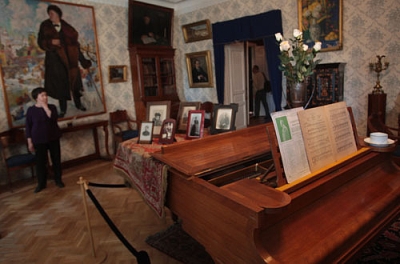

Novinskiy bulvar 25
Tel. (499) 255 6399
Subway: Smolenskaya, Barrikadnaya
Open: 10am- 7pm Wed, Thu
10am- 3pm Sun
The house of F. I. Chaliapin in Moscow is the house-Museum of the
famous Russian chamber singer. Chaliapin and his family lived in
this building from 1910 until their forced emigration to the United
States in 1922. The Soviet government turned it into a communal
apartment, dividing the house with new partitions. It was only in
the 1980s that the building was decided to be renovated. Chaliapin's
descendants participated in the restoration of the interior and gave
away some of their personal belongings. The house of F. I. Chaliapin
was opened on September 23, 1988. There was also a monument to the
singer near the house.
Fyodor Chaliapin was born in Kazan in
1873 and spent his early years in poverty, working in a port on the
Volga until his unique vocal talent was discovered. He made his
international debut at La Scala, Milan, in 1901. He went on to sing
many great operatic bass roles, including don Quixote, Ivan the
terrible, and Boris Godunov. Chaliapin died in Paris in 1938, but
his remains have since been returned to Russia and reburied in the
Novodevichy cemetery along with other famous Russians.
This
is one of the new Moscow house-museums and one of the best. In the
collection of the Chaliapin Museum there are funny drawings of
Chaliapin made by his children, as well as porcelain dolls bought in
France, which adorn the cozy living room with green upholstery. In
the office, portraits of the singer in his various Opera roles hang
on the walls. The carved chair in front of the dining room was a
gift from the writer Maxim Gorky, and the paintings on the walls
were painted by the artist Konstantin Korovin. Other items on
display in the house include the singer's makeup and one of his
wigs. In the concert room, visitors can listen to recordings of
Chaliapin's performances. After singing, Chaliapin often invited his
guests to play Billiards. Chaliapin did not like to lose, and,
depending on his mood, his wife only invited friends with enough
understanding to allow him to win all the games.
Today, the
Chaliapin house hosts concerts of both outstanding contemporary
artists and young performers, as well as competitions, festivals,
and conferences. There are guided tours, lectures, concert
recordings of Chaliapin, evenings of subscription cycles, etc. the
Chaliapin House Museum is one of the branches of the Glinka Museum
of musical culture.
Exposition
The exhibition Of the F. I.
Chaliapin Museum consists of a collection of personal belongings of
the artist, stage costumes, antique furniture, as well as art works
by Valentin Serov, Konstantin Korovin, Vasily Polenov, Mikhail
Nesterov and Mikhail Vrubel and Boris Chaliapin — the artist's son.
The interior rooms were recreated based on the memoirs and notes of
Irina's daughter, Iola's wife, and the stories of contemporaries.
The permanent exhibition consists of a recreated Suite of rooms
on the first and second floors of the mansion. The entrance hall
leads to Iola Chaliapina's room, where her portrait by Boris
Chaliapin, family photos, wedding ribbons and a landscape of Ayu-Dag
mountain hang. Next door is Chaliapin's room, which adjoined the
front hall and the hall connected to the mezzanine. In the dining
room, Chaliapin celebrated with his friends successful benefit shows
— the table could fit more than thirty people. The exhibition
features an original table, as well as artistic works by Konstantin
Korovin. The buffet contains hand-painted sets and symbols of the
Imperial family.
In the Green living room hangs a painting by
the Irish artist O'connell "Portrait of a Gypsy", which, according
to legend, Chaliapin purchased in Brussels. There is also an old
gramophone, a set of records with recordings of Opera singers, as
well as an authentic artist's chair from his apartment in Paris,
where he spent the last years of his life. In this room, a small
troupe of the Chaliapin Studio, which included Ruben Simonov, Osip
Abdulov, Olga Androvskaya, as well as the artist's children — Lydia
and Irina, arranged their performances.
The Cabinet of
Chaliapin was used by the artist to read books located on the book
shelves. The singer's family library included books by Alexander
Pushkin, Ivan Turgenev, Miguel de Cervantes, and William
Shakespeare. On the artist's Desk is a portrait of Anton Chekhov.
The white hall is a concert hall that hosts temporary exhibitions,
as well as musical evenings. In this hall, Chaliapin conducted
rehearsals, which were often attended by other musicians, including
Sergei Rachmaninoff, Arseny Korashchenko, Fyodor Keneman and others.
The hall opened onto a terrace that overlooked the front garden.
The rooms on the second floor display awards and gifts received
by the artist throughout his life. These include the French Legion
of Honor, Lithuanian and Bulgarian awards. Mannequins display stage
costumes in which Chaliapin performed all over the country, and
sketches of scenery by artists Ivan Bilibin and Korovin hang on the
walls. The artist's authentic items are displayed nearby: a hat,
playing cards, cigarettes, as well as a Bechstein Grand piano, which
Rachmaninoff often played at.
The last room of the exhibition
is a billiard room, which contains a table of the company "V. K.
Schultz", given to Chaliapin by his wife Iola, as well as a large
table and a telephone.
"And was our mansion is simply but
soundly; its main attraction was the library of his father, picked
up mostly of A. M. Gorky. The luxury of our house was Billiards,
which my mother bought for my father, who was fond of this game.
The artist's daughter Irina Shalyapina»